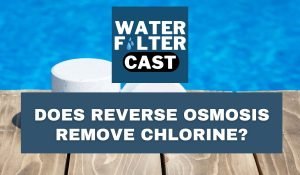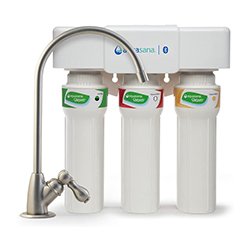Reverse osmosis has now become a very common piece of equipment found in many households with the increase of many contaminants found in water. One such contaminant is chlorine which is added to water to kill bacteria and viruses in it. While they are added for a good purpose, they aren’t a great option for people to consume.

And fortunately, there are many filters available now that can remove chlorine along with many other contaminants. One such filter is the reverse osmosis filter.
In this blog post, we will look into how reverse osmosis can remove chlorine and much other important information in its regard.
How Does Reverse Osmosis Remove Chlorine?
Because chlorine is a gas dissolved in water, it is relatively easy to remove. Simply leaving the water out uncovered will allow the chlorine to evaporate. Chlorides are more difficult to eliminate. They won’t evaporate since they’re already chemical compounds. Instead, a filter must be used to eliminate them.
Chlorine and chlorides cannot be removed by reverse osmosis alone. Instead, RO systems use activated charcoal (carbon) filters to eliminate chlorine before it passes through the reverse osmosis process.
How Much Chlorine Does RO Remove?
Carbon block filters in reverse osmosis water filtering systems are an excellent approach to removing up to 98% of chlorine from water. In a Reverse Osmosis system, a carbon prefilter will not only absorb chlorine during the filtering process but will also prevent the sensitive reverse osmosis membranes from being harmed by chlorine contact.
The revere osmosis membrane in the filter is very sensitive and can get harmed by chlorine, this is why it cannot remove chlorine on its own and requires a carbon filer to remove the chlorine. The carbon filter will remove chlorine and other pesticides in water not only cleaning the water but also protecting the reverse osmosis membrane.
Do All Reverse Osmosis Filters Remove Chlorine?
Most of the reverse osmosis filters now available in the market contain carbon filters within them that can remove chlorine from water. In fact, one of the best-known options to get rid of chlorine in water is with a complete reverse osmosis system.
Since reverse osmosis systems don’t only remove chlorine, but also many other dangerous contaminants such as many pesticides now found in water in water, they have become a widely used water cleaning system.
Only a few reverse osmosis systems that don’t have a carbon filer within the system cannot remove chlorine in the water. But such filters are very rare since if a carbon filter doesn’t remove the chlorine, they will damage the membrane and break the filter within a small time period.
Best RO Systems For Chlorine Removal
Here are two of the best under-the-sink reverse osmosis filtration systems available in the market.
Springwell: Reverse Osmosis Drinking System
If you wish to filter out heavy metals that are commonly found in our city’s drinking water, a Reverse Osmosis system is the way to go. It’s a drinking water and cooking point-of-entry system that’s commonly put under your kitchen sink. Some of the contaminants that this reverse osmosis filter removes are Aluminium, Iron, Chlorine, Chloramine Herbicides, Pesticides, Chlorine Byproducts, and many other contaminants…
The filter has a very efficient filtering system with a four-step process. The first step removes all larger contaminants in the water. The second step is where the carbon filter removes many contaminants like chlorine and pesticides. During the third step, heavy metals in the water are removed from the water. And the filtration ends with the final step where any other contaminant that managed to escape from the three steps gets removed.
Aquasana: OptimH2O® Reverse Osmosis + Claryum®
For optimal health and hydration, the OptimH2O Reverse Osmosis + Claryum combines superior filtration technology with reverse osmosis. This under-sink reverse osmosis system has been tested and certified to NSF/ANSI Standards 42, 53 (including P473), 58, and 401 for the efficient removal of 88 contaminants, including 95% fluoride. It can also remove 95% of mercury, 97.5% of chlorine and arsenic, and 99.5% of lead and asbestos while retaining the valuable minerals that conventional reverse osmosis systems remove. The OptimH2O Reverse Osmosis + Claryum system eliminates 5X more pollutants than other RO systems. To accomplish superior pollutant removal, the OptimH2O Reverse Osmosis + Claryum uses a multi-step filtration technology.
The process starts with an activated carbon filter which removes organic pollutants such as herbicides, and insecticides. The Reverse OsmosisMembrane in the system is scientifically engineered to filter dissolved particles smaller than 1 millimeter, as well as 14 contaminants like fluoride, arsenic nitrates, nitrites, and radium which happens in the second step.
Heavy metals are removed using ion exchange and sub-micron filtration, while beneficial minerals are retained via selective filtering in the third step. The process ends with the Remineralizer replenishing the correct quantity of calcium, magnesium, and potassium lost during the reverse osmosis process, as well as improving pH balance and water alkalinity for healthy, delicious water.
Conclusion
Getting rid of those contaminants in the water is very important for the safety of you and your loved ones as much as adding chlorine to water is. So the best option is removing the chlorine in the water before drinking and the best way to do is by filtering it.
One of the best options to remove chlorine is a reverse osmosis system considering that it also removes many other contaminants and makes our drinking water extra safe. It is up to us to choose the best choice for our loved ones and us.
FAQ
Does Culligan reverse osmosis remove chlorine?
Culligan reverse osmosis is a cutting-edge filtering technology that removes impurities such as arsenic, salt, chloride, fluoride, and radium from water, as well as hazardous bacteria. The water is forced through an extremely fine, semi-permeable membrane that only permits water to flow through while catching all the contaminants.
Does APEC reverse osmosis remove chlorine?
All impurities, including chlorine, taste, odor, harmful fluoride, arsenic, lead, and chromium, are guaranteed to be removed by APEC reverse osmosis. For many years to come, this efficient and productive reverse osmosis system will offer your family trouble-free, high-quality drinking water.







